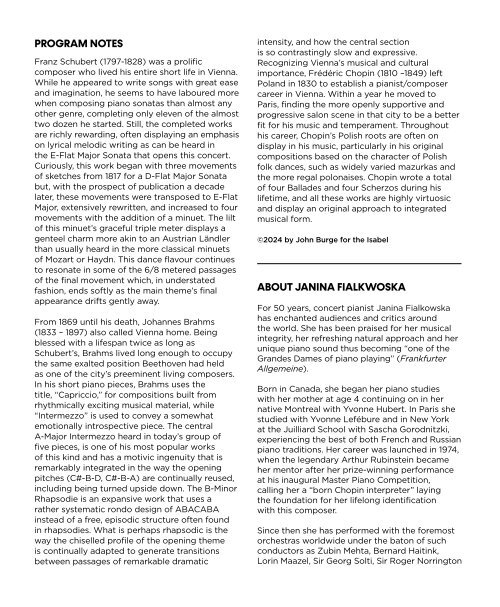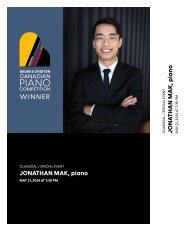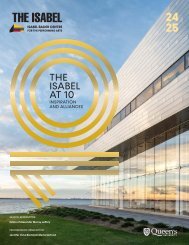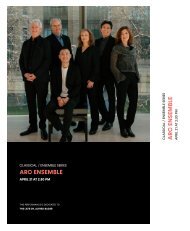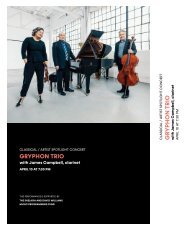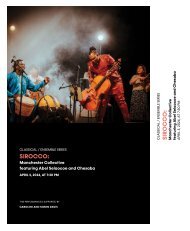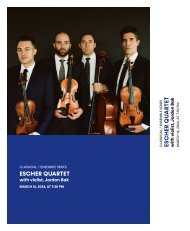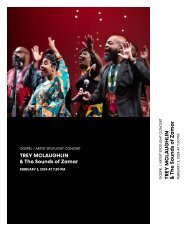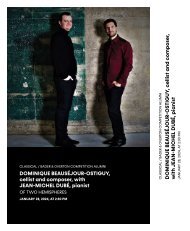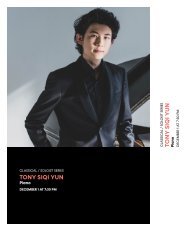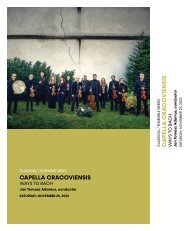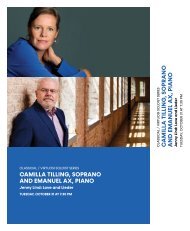Create successful ePaper yourself
Turn your PDF publications into a flip-book with our unique Google optimized e-Paper software.
PROGRAM NOTES<br />
Franz Schubert (1797-1828) was a prolific<br />
composer who lived his entire short life in Vienna.<br />
While he appeared to write songs with great ease<br />
and imagination, he seems to have laboured more<br />
when composing piano sonatas than almost any<br />
other genre, completing only eleven of the almost<br />
two dozen he started. Still, the completed works<br />
are richly rewarding, often displaying an emphasis<br />
on lyrical melodic writing as can be heard in<br />
the E-Flat Major Sonata that opens this concert.<br />
Curiously, this work began with three movements<br />
of sketches from 1817 for a D-Flat Major Sonata<br />
but, with the prospect of publication a decade<br />
later, these movements were transposed to E-Flat<br />
Major, extensively rewritten, and increased to four<br />
movements with the addition of a minuet. The lilt<br />
of this minuet’s graceful triple meter displays a<br />
genteel charm more akin to an Austrian Ländler<br />
than usually heard in the more classical minuets<br />
of Mozart or Haydn. This dance flavour continues<br />
to resonate in some of the 6/8 metered passages<br />
of the final movement which, in understated<br />
fashion, ends softly as the main theme’s final<br />
appearance drifts gently away.<br />
From 1869 until his death, Johannes Brahms<br />
(1833 – 1897) also called Vienna home. Being<br />
blessed with a lifespan twice as long as<br />
Schubert’s, Brahms lived long enough to occupy<br />
the same exalted position Beethoven had held<br />
as one of the city’s preeminent living composers.<br />
In his short piano pieces, Brahms uses the<br />
title, “Capriccio,” for compositions built from<br />
rhythmically exciting musical material, while<br />
“Intermezzo” is used to convey a somewhat<br />
emotionally introspective piece. The central<br />
A-Major Intermezzo heard in today’s group of<br />
five pieces, is one of his most popular works<br />
of this kind and has a motivic ingenuity that is<br />
remarkably integrated in the way the opening<br />
pitches (C#-B-D, C#-B-A) are continually reused,<br />
including being turned upside down. The B-Minor<br />
Rhapsodie is an expansive work that uses a<br />
rather systematic rondo design of ABACABA<br />
instead of a free, episodic structure often found<br />
in rhapsodies. What is perhaps rhapsodic is the<br />
way the chiselled profile of the opening theme<br />
is continually adapted to generate transitions<br />
between passages of remarkable dramatic<br />
intensity, and how the central section<br />
is so contrastingly slow and expressive.<br />
Recognizing Vienna’s musical and cultural<br />
importance, Frédéric Chopin (1810 –1849) left<br />
Poland in 1830 to establish a pianist/composer<br />
career in Vienna. Within a year he moved to<br />
Paris, finding the more openly supportive and<br />
progressive salon scene in that city to be a better<br />
fit for his music and temperament. Throughout<br />
his career, Chopin’s Polish roots are often on<br />
display in his music, particularly in his original<br />
compositions based on the character of Polish<br />
folk dances, such as widely varied mazurkas and<br />
the more regal polonaises. Chopin wrote a total<br />
of four Ballades and four Scherzos during his<br />
lifetime, and all these works are highly virtuosic<br />
and display an original approach to integrated<br />
musical form.<br />
©<strong>2024</strong> by John Burge for the Isabel<br />
ABOUT JANINA FIALKWOSKA<br />
For 50 years, concert pianist <strong>Janina</strong> <strong>Fialkowska</strong><br />
has enchanted audiences and critics around<br />
the world. She has been praised for her musical<br />
integrity, her refreshing natural approach and her<br />
unique piano sound thus becoming “one of the<br />
Grandes Dames of piano playing” (Frankfurter<br />
Allgemeine).<br />
Born in Canada, she began her piano studies<br />
with her mother at age 4 continuing on in her<br />
native Montreal with Yvonne Hubert. In Paris she<br />
studied with Yvonne Lefébure and in New York<br />
at the Juilliard School with Sascha Gorodnitzki,<br />
experiencing the best of both French and Russian<br />
piano traditions. Her career was launched in 1974,<br />
when the legendary Arthur Rubinstein became<br />
her mentor after her prize-winning performance<br />
at his inaugural Master Piano Competition,<br />
calling her a “born Chopin interpreter” laying<br />
the foundation for her lifelong identification<br />
with this composer.<br />
Since then she has performed with the foremost<br />
orchestras worldwide under the baton of such<br />
conductors as Zubin Mehta, Bernard Haitink,<br />
Lorin Maazel, Sir Georg Solti, Sir Roger Norrington


